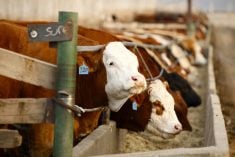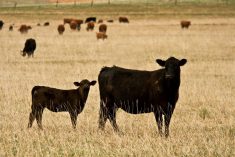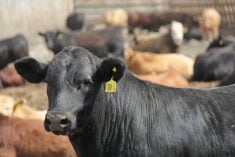Western Canadian feeder cattle prices experienced a mixed tone this past week. Heavier weaned calves were trading steady to as much as $4 higher compared to last week; however, shorter-term replacements were steady to $3 lower. Alberta packers were buying fed cattle in the range of $170 to $172, down from week-ago levels of $177.
Although margins remain extremely favourable, finishing feedlots lowered their bids due to fear that the fed market would continue to fade. Backgrounding operators selling yearlings realized it was harder to find buyers for direct off-farm movement. This sentiment was also noted at major auction barns. Although most sales experienced pretty good numbers this past week, comments from front lines suggest there were only a handful of buyers at times.
Read Also

U.S. grains: Soy futures post biggest monthly gain in nearly five years on China trade optimism
U.S. soybean futures climbed to a 15-month high and posted their biggest monthly gain in nearly five years on Friday following a rally fueled by the prospect of revived exports to China.
Direct off-farm 850-lb. mixed steers with lower flesh were priced at $168 in the Lethbridge area. In central Alberta, exotic steers weighing just under 900 lbs. were quoted at $167; mixed larger-frame, medium- to lower-flesh heifers weighing 825 lbs. were trading from $148 to $150 in the same region.
Heavier weaned calves were quite firm; pasture conditions are quite favourable across the Prairies and there’s plenty of cheap feed grains around. Supplies of these quality calves are dwindling and buyers realized waiting wasn’t an option. Mixed steers weighing just over 600 lbs. reached up to $205 in southern Manitoba; however, in central Alberta there was a small group of mixed Simmental-cross steers averaging 575 lbs. that traded for $215. The market was quite variable as some of these cattle can be quite fleshy at this time of year. Feedlot operators were quick to back away on cattle that wouldn’t perform.
U.S. wholesale beef prices were under pressure for the second week in row and there is concern that the fed cattle market has put in the highs for the year. We’ve all seen how quickly the fed market can change and memories of 2016 continue to haunt feedlot operators.
— Jerry Klassen manages the Canadian office of Swiss-based grain trader GAP SA Grains and Produits Ltd. and is president and founder of Resilient Capital specializing in proprietary commodity futures trading and market analysis. Jerry consults with feedlots on risk management and writes a weekly cattle market commentary. He can be reached at 204-504-8339.













